The Buff Orpington is among the most popular chicken breeds. It is a large and attractive chicken known for its docility, quiet personality, and great temperament.
It is also classified by the American Poultry Association (APA) as a heritage chicken. They naturally mate and have a long, productive outdoor lifespan of 5 – 7 years. Buff Orpingtons make an excellent addition to backyard chicken coops.
Buff Orpington History
When the “chicken fever” died in the 1880s, the novelty of breeding for the sake of acquiring unique and exotic birds went with it. People began taking a new approach to raising chickens, breeding them for practicality and usefulness instead.
This was when a coachman from Orpington town in Kent County, England, by the name of William Cook, entertained the possibility of breeding fowl for that exact purpose. He wanted to turn from the usual aesthetic goals associated with chicken propagation and aim for qualities centered on meat and egg production.
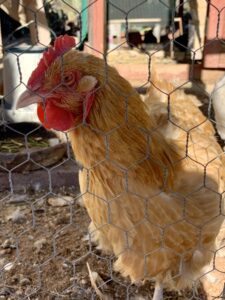
First Feather Colorations
Cook eventually introduced the “Black Orpington”, which gained popularity overnight because of excellent publicity. It was bred to have black plumage to disguise the dirt and soot that was widespread in cities back in those days.
“Buff” Orpington chickens were born soon after. To this day, they remain a breeder’s favorite because of their “buff” color. White and Blue plumage versions followed soon after, and eventually, those with a splash of colors.
All of these birds received high praise from the general public, allowing the Orpington to be recognized as the most popular breed in Great Britain. After a decade, they exported the breed to other countries, including America and South Africa.
The Orpington lineage also earned rave reviews in the United States, which is owed to Cook’s ability to talk business. He was able to encourage farmers and poultry folks to raise this dual-purpose breed.
The “True” Buff Orpington
The black Orpington chicken was the first one of its kind. It was born from Cook’s original selection of Langshan, Minorca, and Plymouth Rocks. As well-received as this fowl was by the public, it wasn’t anywhere near what you would describe as buff.
The original buff Orpington chickens came to be because of the genetic introduction of breeds like Dorkings, Hamburgs, and Cochins into the pioneering black Orpington bloodline.
People also alleged that the Lincolnshire buff was part of this combination, although Cook denied this.
There was a lot of controversy surrounding Cook’s methods back then. Even today, the system of using different breeds to create birds of various colors but with the same name is generally unheard of.
The Orpington was created because there was a need for a buff-colored chicken. The unconventional techniques that led to the breed also did nothing to quell its popularity with people, including the Queen Mother Elizabeth Bowes-Lyon.
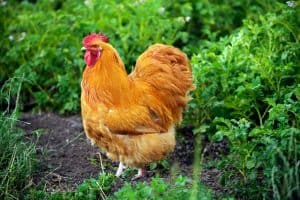
Current Status
Up until recently, Orpingtons were considered endangered. However, thanks to the breeders who kept breeding them, they eventually made it out of the American Breed Livestock Conservancy list in 2016. Since then, they garnered so much renewed interest that their numbers rose steadily.
Physical Characteristics of Orpington Chickens
As a backyard chicken keeper looking to introduce the Orpington to your flock, you should be well aware of the breed’s standard physical characteristics. It is also important to learn about the differences between the UK and USA variety.
Size and Weight
Like many fowl breeds, the Orpington also comes in two sizes—the large and the bantam. The variety of Orpingtons were accepted by the American Poultry Association (APA) at different dates.
The “Buff” variety was admitted first in 1902, followed by the Black, White, and Blue versions in 1905, 1905, and 1923, respectively. Buff Orpringtons resemble Buff Plymouth Rock chicken also called Buff Rocks or Buff Plymouth Rocks.
The large rooster version is around ten pounds, while the buff Orpington hen is approximately eight pounds. As for the bantam size, you should expect them to weigh in at 34 ounces for the female and 38 ounces for the male.
If you happen to be interested in larger bantams, then the Orpington is one of the best breeds to find them.
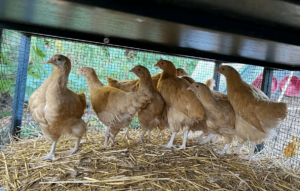
Height
Standing between 12 and 15 inches, standard Orpingtons are relatively tall as far as chickens go. While the rooster is typically larger than the hen, both sexes still average over a foot in height.
Buff Orpington Appearance
A true Orpington chicken should have the following characteristics:
Body:
The Orpington should have a broad and heavy body with a low stance, while its back should be short and curvy.
Feathers:
A distinctive feature of the Orpington is its well-feathered body surrounded by smooth, broad feathers. Its plumage should also have the appearance of being fluffed-out.
Feet, Shanks, and Beak:
The Orpington should have pinkish-white-colored feet, shanks, and beak, plush white-colored flesh.
Eyes, Wattles, Earlobes, and Comb:
The Orpington should have wattles, earlobes, eyes, and combs that are reddish bay in color. Its comb should be a single structure with five points, but a rose-comb variety of Orpington also exists.
USA Standard vs UK Standard Orpingtons
British-bred Orpingtons are slightly different from their American counterparts in that they have deep and broad bodies with short tails. Their feathers also neither appear to be tucked too closely nor fluffed-out like the USA variety. American Orpingtons also outmatch their British cousins in terms of egg-laying capabilities.
That is because the USA breed has more concentrated genes of the Plymouth Rocks and the Wyandottes, both of which were known for their superior egg productivity.
Are Buff Orpingtons Friendly?
While the whole gamut of Orpingtons is known for their friendly and docile attitudes, the “buff” variety is especially known to exhibit this kind of personality. It goes about its business in a calm, regal manner, barely paying attention to anything except when it is scrambling for treats.
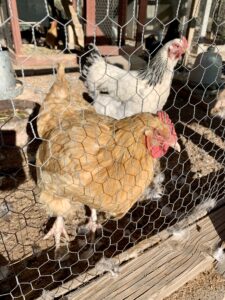
Orpingtons can often be attention seekers, seeking out their human parents for some cuddling. They also make great parents, particularly the hens, who will accept any hatching eggs placed under them.
Roosters also step up to the parenting role. Buff Orpington roosters protect their brood fiercely and briefly take the role of a buff Orpington hen to give the mother a break.
Chicken keepers with kids will also find the Orpington a great choice. Orpingtons are some of the most child-friendly chickens out there, remaining mostly tolerant of typical child behavior.
Of course, this isn’t to say you should leave your youngsters alone with them since they can still deliver a painful peck when threatened. These chickens also make excellent show birds because they won’t ever be annoyed at constant handling. They are known for taking unusual environments, strange noises, and unconventional handling techniques in stride.
Other friendly chickens that are compatible in the coop with buff orpingtons are are cochin chickens and the golden comet chicken. Of course, you can also raise them in a flock with other orpringtons, such as lavender orpington.
Are Buff Orpingtons Cold Hardy?
Depending on where you live, snow is something chicken keepers and flocks may have to deal with. There are many proven practices for managing backyard fowl in the cold, including selecting cold-hardy chickens like Orpingtons.
Orpington’s Cold-Hardy Characteristics
Orpingtons give you one less thing to worry about during the winter since they possess dense, thick feathering that helps them tolerate plummeting temperatures. They are also larger than other breeds and can store more fat to help them survive long winter nights.
When it gets particularly chilly, Orpingtons also huddle together and use each other’s body heat to keep warm. Thus, it’s important to keep multiple chickens in a coop together during the cold months.
Orpingtons can also keep their body heat close to the skin by fluffing out their plumage. They also have featherless feet and small combs and wattles that make it difficult for them to become frostbitten.
Lastly, they tuck their feet and legs under their bodies for additional warmth, and since they are well-feathered, they will have no skin exposed to the bitter cold.
How Do You Raise Orpingtons?
The good news is that raising an Orpington isn’t any different from raising other chicken breeds. Just make sure you’re familiar with their specific needs. Learn about raising backyard chickens for beginners. Here are the things to keep in mind when you plan to raise Orpingtons:
1. Provide Appropriate Shelter
Orpingtons are excellent for any kind of breeding scenario, whether it takes place in an open range or a limited, confined space. While raising chickens in confinement is never the best way to go about things, if you decide to take that route, you’ll find that your Orpingtons can handle it well.
Your coop should have a structure that allows chickens to take shelter from the elements easily. As well-adapted as Orpingtons are, they are still vulnerable to the heat, cold, and rain. That is particularly true regarding the rain since this breed’s feathers make it difficult for them to dry off quickly.
Building a coop with enough dry areas is especially important if you plan to adopt Orpingtons into your flock. Orpingtons have also become a staple in chicken tractors or mobile pens because of their ability to handle a wide range of environments.
Mobile coops allow this breed to get adequate exercise without causing their bodies to overheat. They are the ideal home for Orpingtons, giving the chickens access to fresh pasture at all times, which contributes to the development of high-quality meat.
That said, in case you’re raising these chickens in extreme climates, you may want to steer clear of the chicken tractor.
A mobile pen doesn’t give your flock nearly enough protection from the elements as a well-built backyard chicken coop. Even better is a shed or other indoor or protected space.
2. Check Your Area’s Seasons
Since the Orpingtons originated in English barnyards, Orpingtons will thrive best in locations with colder winter seasons and milder summers.
3. Feed Properly
Orpington birds can be fed regular broiler feed or egg, depending on your goals. Otherwise, you may supplement their diet with mealworms, certain fruits, and other healthy treats. To boost your chicken’s long-term health, you’ll want their core diet to consist of pellets containing wheat, salt, oats, sunflower seeds, and corn.
This specially-formulated feed has the right vitamins and minerals your Orpingtons need.
Also, remember that these birds are large and have voracious appetites. While almost anything is good food for them, you want to make sure that doesn’t include tomatoes, potatoes, asparagus, avocados, and onions. Learn can chickens have strawberries and other ideas. These particular fruits and vegetables have certain toxins that can affect your chicken’s health and productivity.
4. Be Mindful of Their Health
You should also always be on the lookout for common health issues in chickens. You may have some of the most tolerant chickens in your flock, but that doesn’t mean they are immune to bumblefoot, spraddle leg, or impacted crops.
They could still be affected by these issues, so it’s important always to be vigilant. Have them vaccinated and regularly checked by your veterinarian. They also need to be checked regularly for creepy crawlies because of their dense feathers. Aside from keeping an eye out for common chicken diseases, you also need to keep watch over this breed’s weight.
They tend to be on the heavy side, which makes them lazy and prone to obesity. You can maintain your flock’s health by making sure they get their regular exercise.
Lastly, these chickens need regular access to shade, clean drinking water, and ventilation during the warmer months to keep them from overheating.
FAQs Regarding Buff Orpington Productivity
1. How Are Buff Orpingtons at Egg Production?
These birds lay about 200 eggs annually and can even surpass 250 eggs in one calendar year. Also, once they start laying eggs, they aren’t known to stop for as long as they are healthy.
Orpington hens are broody, which makes them phenomenal at taking care of developing chicks. Still, this broody personality trait does come with its challenges.
It can cause hens to become watchful and aggressive, making it difficult for keepers to gather eggs from beneath them.
Egg-laying hens can also be territorial, hiding their eggs in difficult-to-access locations and making it a hassle for keepers to look for them. Even still, these are among the best egg-laying chickens for eggs.
2. What Color Eggs Do Buff Orpingtons Lay?
Buff Orpingtons can lay between 200 and 250 large, pale-brown eggs per year. They can also lay medium-sized eggs depending on the hen’s personality and the time of the year.
Some hens can lay eggs throughout the entire year, including the winter season. Their eggs are also some of the largest you will find in any chicken breed.
3. How Many Years Do Buff Orpington Chickens Lay Eggs?
A Buff Orpington hen’s prime egg production period is from two to three years. Beyond this, expect a drop in at least one egg per day or a few eggs per week. Then, expect the drop to be more significant, even reaching zero production, during the molting process.
However, please note that active egg-laying years would depend on the climate, feed, stress, and other factors the hens are exposed to regularly.
4. How Are Buff Orpingtons at Meat Production?
Buff Orpingtons are a popular source of chicken meat because they have good weight and a more straightforward coop-to-table process compared to other chickens. Plus, they produce a good amount of meat that is also tough enough to handle a variety of conditions.
At just 22 weeks, you can already raise Buff Orpingtons for meat. That means you won’t have to spend as much for feed and housing as you would when raising other breeds for meat production. Buff Orpingtons are among the top choices for meat chickens.
Should You Choose Buff Orpingtons?
If you’re looking for a chicken with fabulous plumage, a friendly disposition, and a great layer, this breed will make an awesome choice.
Unless you count brooding hens, these chickens interact well with people and will hardly be the cause of any challenges. Expect them always to hurry to you to ask for treats and attention.
Whether you have a small or big yard, live in the city or the country, or live in a cold or hot climate, you shouldn’t have a problem taking care of these birds.
Orpingtons are great for beginner-level keepers because of their low-maintenance requirements and tolerance for unusual environments, weird noises, and unconventional handling techniques.You basically take care of them as you would any other chicken breed, providing proper shelter with adequate shade. Like most chickens, they would require round-the-clock access to clean water and ventilation, regular vet checks, and exercise.
The Buff Orpington is definitely a favorite of many breeders. It’s one of the more convenient breeds to raise and offers a great many benefits productivity-wise.
Plus, it’s a heritage chicken and prized just as much for being a piece of culture and history as it is for its beauty and practicality.
Lastly, the Orpington has taken the concept of dual-purpose chicken to a new level. People raise them for eggs as well as meat. They are large, robust, and well-adapted chickens that are also cold-tolerant and friendly.

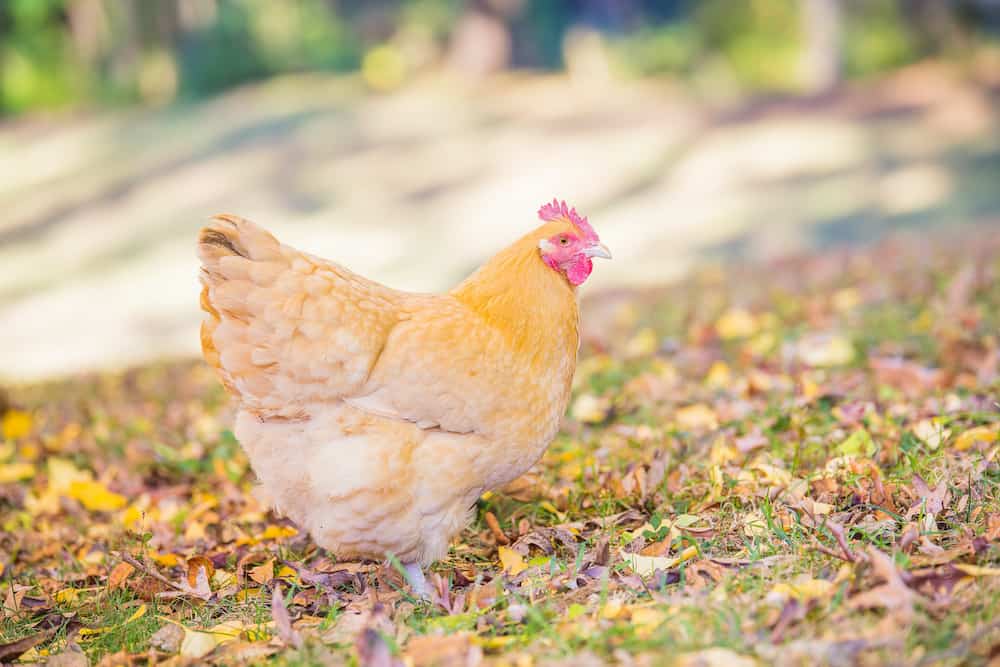
I feel like encouraged in this project, keep it up.